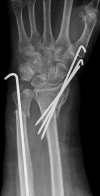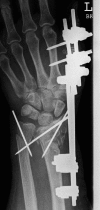Aspects of current management of distal radius fractures in the elderly individuals
- PMID: 23569689
- PMCID: PMC3609400
- DOI: 10.1177/2151458511426874
Aspects of current management of distal radius fractures in the elderly individuals
Abstract
Diatal radius fractures (DRFs) are typical fractures of relatively fit persons with osteoporotic bone who remain active into older age. Traditionally, DRFs in older patients have been treated with closed reduction and cast immobilization. Considering the increasing life expectancy of the elderly population, appropriate management of these fractures is of growing importance. Decision making for surgical or nonsurgical approach to osteoporotic DRFs is difficult. These decisions are often made based on the data from treatments of much younger patients. The current literature concerning the treatment of DRFs in the elderly individuals is more controversial. Some investigators have recommended open reduction internal fixation (ORIF) as treatment for unstable DRFs in older patients, while others have suggested that elderly patients should be treated nonsurgically even if there is an unstable fracture situation because fracture reduction is not associated with functional outcomes as in younger patients. This article reviews the different treatment options for DRFs in the elderly individuals reported in the recent literature.
Keywords: distal radius fracture; elderly; geriatric trauma; osteoporosis; treatment.
Conflict of interest statement
Figures




References
-
- Mackenney PJ, McQueen MM, Elton R. Prediction of instability in distal radial fractures. J Bone Joint Surg Am. 2006;88(9):1944–1951 - PubMed
-
- McQueen M, Caspers J. Colles fracture: does the anatomical result affect the final function?. J Bone Joint Surg Br. 1988;70(4):649–651 - PubMed
-
- Beumer A, McQueen MM. Fractures of the distal radius in low-demand elderly patients: closed reduction of no value in 53 of 60 wrists. Acta Orthop Scand. 2003;74(1):98–100 - PubMed
-
- McQueen MM, Hajducka C, Court-Brown CM. Redisplaced unstable fractures of the distal radius: a prospective randomised comparison of four methods of treatment. J Bone Joint Surg Br. 1996;78(3):404–409 - PubMed
LinkOut - more resources
Full Text Sources
Medical
Miscellaneous

